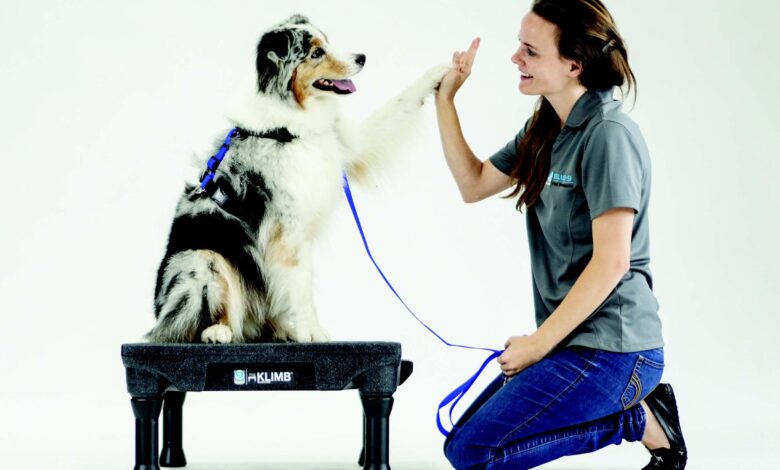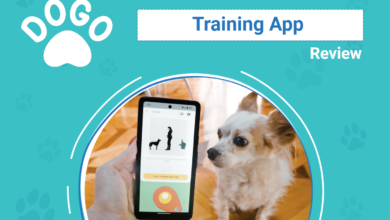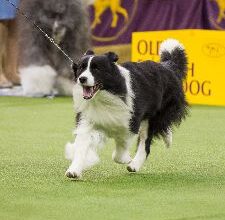The Rise of Platform Training – Dogster

The magic of animals on platforms dates back some 160 years to trained horses on boxes and later to circus lions on pedestals. There’s just something about your own perch. And dog trainers have taken notice.
“The circus world learned that if you put an animal up on a platform that they can stay on, they’ll be perfectly happy to stay there,” says Michele Pouliot, a positive reinforcement trainer and international clinician who champions the use of platforms through canine freestyle.
“I think in about any kind of dog training, you can come up with a logical reason to use some kind of platform,” Michele says. And for many dogs, it has become an ideal place for times when the doorbell rings or during meals.
Michele witnessed the benefits of the box by accident while training for competitive obedience in a California training facility in the 1970s. Years later, when she started freestyle, she brought the box out of storage. Her dogs learned the mixture of obedience, trick training and dance cues rapidly through building up a reward history within a clearly defined space.
Why It Works
Both dog and human have clarity of position by delineating their place on a raised surface. “It gives them a clear defined boundary … Having that and a particular default behavior on that boundary is what you are really looking for,” says certified professional dog trainer Heather Lawson.
Heather encourages an automatic down as a default because it is a relaxed position, and you really do want your dog to stay there. “In reality, they don’t do a lot of sitting. It is only because we ask them to sit.”
Plus, it’s great for an older dog new to your home, because the platform creates a sense of structure and a place for security, Heather explains. Teaching your senior to go to a particular location such as a dog bed or mat moved to a different location becomes an easy transition at the vet and easily accomplished by placing the mat on top of the platform while training. It’s a two-for-one! Platforms can provide conditioning opportunities for your older friend. (See professional dog trainer and movement specialist Lori Stevens’ specially created protocol Two Paws Up for Seniors in the sidebar on page 52).
After six to eight weeks, they’ll be stronger and ultimately more confident to move Lori says. Note: For all dogs, and particularly older dog safety, place a non-skid material underneath to prevent the platform sliding on slippery floors like wood and tile.
When using a platform to train puppies, training time is key. Choose it carefully so your puppy is able to focus on staying on the platform. Exercise the puppy beforehand, so he’s more likely to stay put, and keep sessions short and sweet.
Use For Home
- The platform is a great tool to teach household manners, such as:
- Stopping door charging when the doorbell rings
- Polite greetings for people entering the house
- Basic cues like sit, lie, stay
- Preventing counter surfing during meal prep time
It also helps improve impulse control, creates a specific place to go to rather than in off-limits areas, such as living room furniture, and provides a go-to spot during mealtime.
Heather uses games for teaching stationary house manners. Make platform time exciting and a “place where all good things happen,” she says. All you need is a raised surface, high-value treats and for Fido to love it!
Get Started
Of course, the first step is to train your dog on how to use the platform.
- Lure her onto the platform and into a Down position with a favorite treat. Mark with a “Yes!” or “Good!” Treat and praise. (Puppies can start on a fuzzy bathmat. There must be a tactile difference between the mat and the floor surface, though.)
- Practice stepping onto the platform and off. Repeat up to five times, on and off. Stop luring when there’s enough history built that you can stand back as your dog offers the behavior.
- Add the cue “Place.”
Stay On Place
The second step is to teach her to stay on the platform (Stay On Place).
- Tell your dog “Place.” Once she is on the platform, pause for a count to three with your pup in place, then mark with “Yes!/Good!” and reward.
- When the time is finished, cue her to get off the platform with the release cue “OK!” Then throw a treat away from the platform as a release to get off the station.
- Repeat this process five times to build a history of success. Once she has this, you’ll want to add duration in small increments up to a count of 10 to 15 seconds.
- Ping-pong between shorter and longer time periods (3 seconds, then 10 seconds, then 5 seconds, etc.), gradually exceeding 15 seconds. If she breaks (gets off the platform), no worries. Lower your criteria and go back to the point of success. The process is the same with adults or puppies. Go slowly and have lots of patience.
For multi-dog households, you need to train one dog at a time, then have one dog practice a Stay on the platform while working with the other. Remember the dog on Stay is also working. Reward him, too!
Let’s Play a Game
Next, it’s time to add some distance once your dog understands getting on and off the platform. Around the Clock is a great game for adding distance, as your dog will likely need to go to her station from afar.
- Start with having your dog stay on the platform at the position of 12 o’clock, then toss the treat, and say, “OK” to release.
- As she returns, cue “Place.” When she’s down on the platform, mark with “Yes!/Good!” and reward.
- Toss the treat around using Around the Clock positions, helping your dog understand returning to the platform and into Down. Give loads of praise and treats.
- Add the “Stay” cue (for her to stay on the platform) putting distance between you and your dog/the platform after multiple sessions. This means as you release her and she goes out for the treat, take a step away from the platform until gradually you’re across the room. Remember to reward!

Adding Distractions
Once your dog has duration and distance down, it’s time to add distractions with the Mind Your Business game.
- Ask for “Place,” then mark and reward with high-value treats.
- Show a low-value toy to your dog. If she doesn’t leave the platform, reward generously for the Stay.
- Reset with an “OK” to release her off the platform. Then cue her back on. Wiggle the toy, and toss it in the air while encouraging a Stay. Praise and reward for staying put with a high-value treat.
- Next, try placing the toy on the floor. Ask for Stay. Reward when she does.
Move on to try distracting her with different toys. Low-value treats can also be used as a food distraction. Just place them on the floor and ask for “Stay.” Treat if she stays. (Rule of thumb: Reward treats must be of higher value than the distraction.) Stop after five to 10 reps or before your dog tires. Leave your friend successful and wanting more.
Next are the real tests: Visitors and the doorbell. Make them a game. Start with a family member entering the room, giving your dog a Stay on place on the platform. Increase the level of distraction with other people entering once she has been successful nine out of 10 times. With the doorbell:
- Use a doorbell ringer app or your doorbell. Stand close to the platform. Ring the doorbell. Cue her to Place.
- Once on the platform, encourage a Stay. Reward and practice.
- Progress slowly and in short sessions. (If you’d like the doorbell as the Place cue, gradually increase the time between doorbell and the “Place” cue.)
After the game is understood, add going to the door while your dog is on place. Keep the treats coming!
Look For Joy
The platform offers a happy place where you make it easy for your dog to succeed and be rewarded. Michele agrees. “It’s an easy way to get behavior whether you want them to stay there or for an elephant to put a foot up on a pedestal. It’s a natural thing for them to do.
Platforms give security and structure to your dog and make a great go-to spot during mealtimes, when the doorbell rings or to trick train.
Getting a Platform
Platforms (also called place boards) are used for training in multiple dog sports. Purchase online (see right for vendors) or DIY (instructions below). The rule of thumb is: It has to be big enough for your dog to turn around and lie down if you want her staying there. The easy way — measure the floor space while she is lying down. Height can be around 12 inches or as low as a mat for seniors.
Platform Vendors:
Cato Boards; catooutdoors.com
KLIMB Platforms; blue-9.com
K9 Play Products; k9playproducts.com
Kuranda Beds; kuranda.com
Feel up to making your own platform? For this DIY project, you will need:
- Foam insulation board (available at hardware stores)
- Yoga mat
- Contrasting color duct tape
- Box cutter/utility knife
- Nontoxic glue (optional)
- Straight edge
- Measuring tape
- Permanent marker
Steps:
- Measure the amount of space needed for your dog (measure the floor space while she is lying down.)
- Measure the space needed on the foam board. Mark with a straight edge and marker.
- Cut to size using a utility knife (For a taller platform, cut two boards and glue or duct tape together.)
- Cut the yoga mat to size to fit the top. Glue in place if desired or tape it down with duct tape.
- Finish board edges using duct tape around the perimeter.

Two Paws Up For Seniors
“Aging dogs get weak in the hind end first,” says Lori Stevens, professional dog trainer and movement specialist. For a therapeutic twist using platforms for strengthening the hind end, give Lori’s Two Paws Up a try. Allow six to eight weeks to see a stronger dog with more confidence to move.
Get your vet’s approval beforehand for low-maintenance exercises, and make sure anti-slip material covers the platform.
Lori’s Two Paws Up
- Start with a lower-level platform that meets the needs of your dog. Lure one paw up. Mark with “Yes!/Good!” Encourage two paws up. Mark and reward while only front paws are on the platform.
- When finished, toss a treat away from the platform and release with “OK!”
- Once your dog understands, add a cue of your choice, like “Paws up!” Slowly build endurance with front paws on the platform up to 10 seconds.
- Proper alignment with the hind legs is important. If the hind legs are wider than the front paws, it’s too difficult. Lower the number of seconds, or the height of the platform or the number of repetitions.
- Increase duration, slowly strengthening the hindquarters. Add another five seconds every seven to 10 days working toward 30 seconds. Once successful, platform height can be increased, but lower the number of seconds initially when height increases.
- Another idea: Lure your dog to walk over the platform pausing and treating when front paws reach the floor and with hind legs on the platform.
Watch for any sign of pain or fatigue. Give plenty of breaks moving at the pace of your dog’s comfort.
Source link






